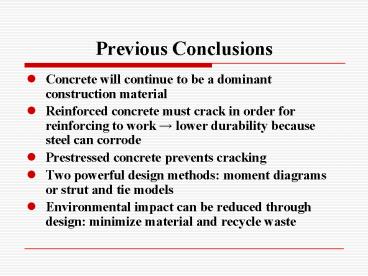Previous Conclusions - PowerPoint PPT Presentation
1 / 39
Title:
Previous Conclusions
Description:
Ductility. Buckling. Shear diagrams. Steel Structures. Recent structures in steel ... Steel offers many advantages, primarily high strength and ductility ... – PowerPoint PPT presentation
Number of Views:96
Avg rating:3.0/5.0
Title: Previous Conclusions
1
Previous Conclusions
- Concrete will continue to be a dominant
construction material - Reinforced concrete must crack in order for
reinforcing to work ? lower durability because
steel can corrode - Prestressed concrete prevents cracking
- Two powerful design methods moment diagrams or
strut and tie models - Environmental impact can be reduced through
design minimize material and recycle waste
2
Steel Structures
- Technical concepts
- Structural failure
- Ductility
- Buckling
- Shear diagrams
3
Steel Structures
- Recent structures in steel
- Material properties definitions
- Structural failure
- Environmental issues
- Conclusions
4
Stuttgart Airport, 1991, Germany
5
Structural Design in Steel
- Can resist tension and compression
- Slender elements in compression may buckle
- Very lightweight structures, so vibrations are a
problem - Follow moment diagram to minimize material use
6
Why is steel a good structural material?
- High strength
- Ductile material
7
Ductility of Steel
8
Ductility of Steel
9
Importance of Ductility
- Large displacements before collapse (as opposed
to a brittle material, which fails suddenly) - Energy dissipation as the steel yields (important
for resisting earthquakes and other overloading)
10
Yield Stress of Steel
11
Yield Stress of Steel
12
How far down can a steel cablehang under its own
weight?
13
Bending Stresses in a Beam
14
Steel Section Terminology
15
Steel Section Terminology
16
Shear Diagrams
17
Shear Diagrams
18
Shear Diagrams
19
Shear Diagrams
20
Shear Diagrams
21
How to draw a shear diagram
- 1) Determine external reactions on beam
- 2) Walk along beam with your pen
- 3) Pen goes up and down with the loads
- 4) Must close diagram at the ends of thebeam
22
Shear Diagrams
23
Shear Diagrams
24
Shear Diagrams
25
Structural Failure
- STRENGTH
- Material failure
- Buckling (due to instability of section)
- SERVICEABILITY
- Excessive deflections or vibrations
- Cracking (usually in concrete)
26
Stiffness of Steel
- STRENGTH
- Higher yield stress allows smaller sections
- but
- SERVICEABILITY
- Stiffness of steel is constant (modulus of
elasticity, E) - Deflections, vibrations, and buckling become more
common
27
Shear Diagram for Uniform Load
28
Shear Diagrams
- Shear diagram equals the slope of moment diagram
29
Is steel a green material?
30
CO2 Emissions for Steel
31
Recycled content for steel
- Each ton of recycled steel saves 1200 pounds of
coal
32
Environmental Advantages of Steel
- Lower weight reduces foundation requirements
- Highly recycled and can continue to be recycled
indefinitely - Durable, if protected from corrosion
33
Environmental Disadvantages of Steel
- Very high energy use, predominantly from burning
coal ? produces pollution - Lightweight, so lower thermal mass compared to
concrete ? requires more insulation - Is susceptible to corrosion
34
Corrosion of Steel
- Corrosion costs around 4 of GDP
- Every 90 seconds, across the world, one ton of
steel turns to rust of every two tons of steel
made, one is to replace rust.
35
How to avoid corrosion?
- Careful detailing to protect from water
- Use stainless steel
- Protect steel with galvanizing (zinc coating) or
other protective coating
36
Stainless Steel Disadvantages
- High initial cost
- Difficulty in fabricating can often result in
costly waste - Difficulty in welding
- High cost of final polishing and finishing
37
Conclusions
- Steel offers many advantages, primarily high
strength and ductility - Shear diagrams can be used to determine locations
of high stresses (and are helpful in drawing
moment diagrams) - Lightweight structures are susceptible to
vibrations and excessive deflections - Environmental impact can be reduced through design
38
Ecological Profile of Materials
39
Ecological Footprints































